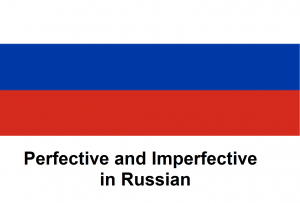Language/Russian/Grammar/Perfective-Imperfective
Hello everybody,
In today's lesson, you will learn some useful vocabulary about ¨Perfective Imperfective¨ in Russian. As you dive into the world of Russian grammar, understanding the difference between perfective and imperfective verbs is essential.
Feel free to edit this page by adding new words and expressions! Happy learning! 🙂
After mastering this lesson, you can also explore other related topics, such as the Dative Case, Russian Grammar - A vs И, and the Russian cases to further enhance your knowledge of the Russian language.
Happy learning! 📚
One of the most important aspects of Russian grammar is aspect, which refers to the way verbs express the completion of an action. In Russian, there are two aspects: perfective and imperfective. This lesson will explain the difference between the two aspects and how to use them correctly in Russian.
IMPERFECTIVE ASPECT (Несовершенный вид)[edit | edit source]
The imperfective may be used in all three tenses in Russian: present, past and future. The actions must be seen as a process – incomplete, habitual, repetitive, or in general. Imperfective verbs also refer to actions that take place simultaneously or where there is an interruption. When in doubt, or if the result is unclear, the imperfective should be used as the default mode.
The perfective aspect expresses a completed action, either in the past, present or future. The perfective aspect is formed by adding a prefix to the root of the verb. There are many prefixes in Russian that can change the meaning of the verb, for example:
- Пойти (to go) → сходить (to go and come back)
- Писать (to write) → написать (to write something)
- Жить (to live) → прожить (to live through something)
The perfective aspect is used in the following situations:
- Completed actions, e.g. Я написал письмо (I wrote a letter)
- One-time actions, e.g. Я сходил в магазин (I went to the store)
- Actions that are not ongoing, e.g. Я закончил работу (I finished my work)
- Actions that have a goal or result, e.g. Я купил книгу (I bought a book)
PERFECTIVE ASPECT (Совершенный вид)[edit | edit source]
The perfective aspect, by its nature, has only two tenses in Russian: past and future. Since the present tense is “in progress,” it cannot be completed. Perfective verbs are often used where there was or will be a completed action. In addition, in questions where the interlocutor specifically asks about an event using the perfective aspect, the same aspect is used in the response.
The imperfective aspect expresses an ongoing or incomplete action. Unlike the perfective aspect, the imperfective aspect does not have a prefix added to the root of the verb. The imperfective aspect is used in the following situations:
- Ongoing actions, e.g. Я пишу письмо (I am writing a letter)
- Repeated actions, e.g. Я каждый день хожу в школу (I go to school every day)
- Actions that are not completed, e.g. Я учу русский язык (I am learning Russian)
- Actions that do not have a specific goal or result, e.g. Я читаю книгу (I am reading a book)
Perfective-Imperfective Pairs[edit | edit source]
Many Russian verbs have both a perfective and an imperfective aspect. The perfective-imperfective pairs are formed from the same root verb, but have different prefixes. For example:
- Идти (to go) - пойти (to go and come back)
- Готовить (to prepare) - приготовить (to prepare something)
- Читать (to read) - прочитать (to read something)
It is important to use the correct aspect depending on the situation. For example, if you want to say that you are reading a book, you should use the imperfective aspect: Я читаю книгу. But if you want to say that you have finished reading a book, you should use the perfective aspect: Я прочитал книгу.
Part 4: Aspect in the Past Tense In the past tense, the perfective aspect indicates a completed action in the past, while the imperfective aspect indicates an ongoing or repeated action in the past. For example:
- Я написал письмо (I wrote a letter) - perfective aspect
- Я писал письмо (I was writing a letter) - imperfective aspect
Aspect in the Future Tense[edit | edit source]
In the future tense, the perfective aspect indicates a specific, one-time action that will be completed in the future, while the imperfective aspect indicates an ongoing or repeated action in the future. For example:
- Я напишу письмо (I will write a letter) - perfective aspect
- Я буду писать письмо (I will be writing a letter) - imperfective aspect
Aspect with Motion Verbs[edit | edit source]
Motion verbs are a special category of verbs in Russian that require a specific aspect depending on the direction of motion. The general rule is that the perfective aspect is used for motion towards a goal or destination, while the imperfective aspect is used for motion without a specific destination. For example:
- Идти (to go) - пойти (to go and come back)
- Везти (to transport) - привезти (to bring)
- Лететь (to fly) - прилететь (to arrive by plane)
Conclusion[edit | edit source]
In summary, aspect is an important aspect of Russian grammar that indicates whether an action is completed or ongoing. The perfective aspect is used for completed actions or actions with a specific goal, while the imperfective aspect is used for ongoing or repeated actions without a specific goal. It is important to use the correct aspect in the appropriate situation, especially when using motion verbs or talking about the past or future.
Author[edit | edit source]
Other Lessons[edit | edit source]
- The verb to have
- Tricky Adverbs
- Gender
- Russian cases
- Very important rules
- Personal Pronouns
- Sentense Structure
- Punctuation
- А vs Но

